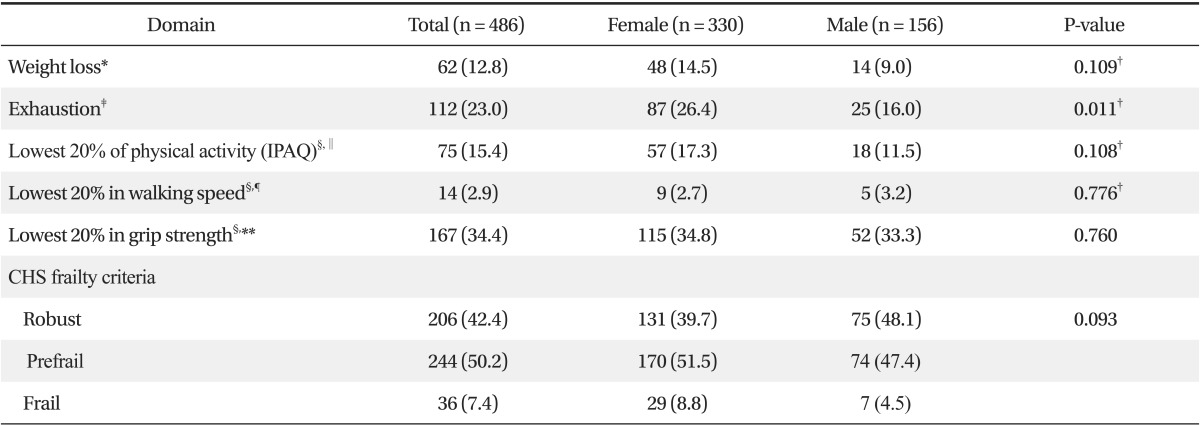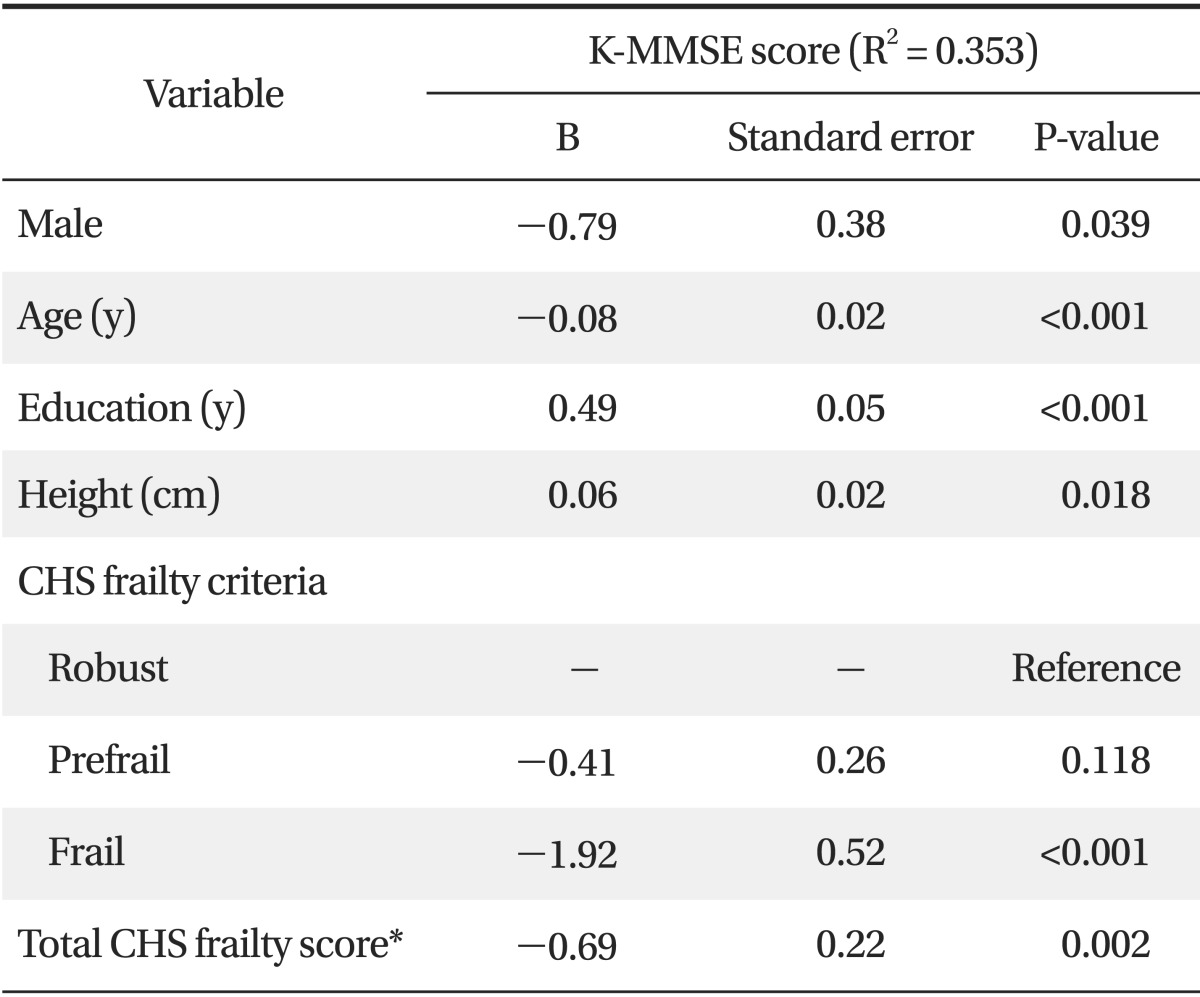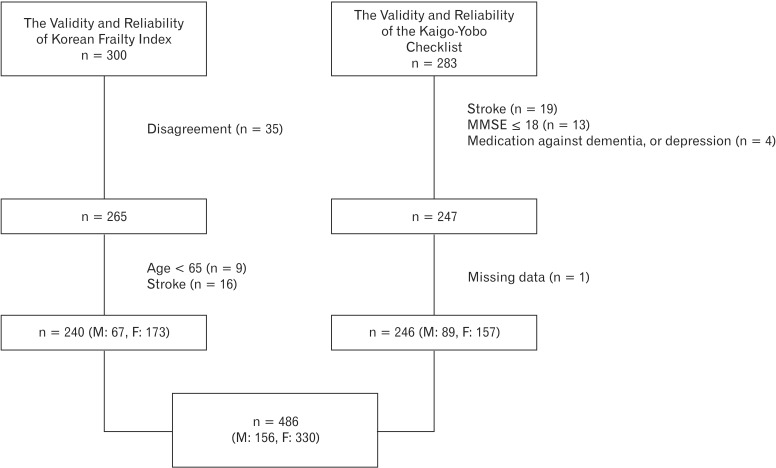1. Korea Institute for Health and Social Affairs. A base study for 2008 living profiles and welfare service needs of older persons in Korea's survey. Seoul: Korea Institute for Health and Social Affairs; 2008.
2. Statistics Korea. Population projections for Korea. Daejeon: Statistics Korea; 2006.
3. Robertson DA, Savva GM, Kenny RA. Frailty and cognitive impairment: a review of the evidence and causal mechanisms. Ageing Res Rev 2013;12:840-851. PMID:
23831959.


4. Fried LP, Tangen CM, Walston J, Newman AB, Hirsch C, Gottdiener J, et al. Frailty in older adults: evidence for a phenotype. J Gerontol A Biol Sci Med Sci 2001;56:M146-M156. PMID:
11253156.


5. Rockwood K, Fox RA, Stolee P, Robertson D, Beattie BL. Frailty in elderly people: an evolving concept. CMAJ 1994;150:489-495. PMID:
8313261.


6. Allegri RF, Glaser FB, Taragano FE, Buschke H. Mild cognitive impairment: believe it or not? Int Rev Psychiatry 2008;20:357-363. PMID:
18925484.


7. Avila-Funes JA, Amieva H, Barberger-Gateau P, Le Goff M, Raoux N, Ritchie K, et al. Cognitive impairment improves the predictive validity of the phenotype of frailty for adverse health outcomes: the three-city study. J Am Geriatr Soc 2009;57:453-461. PMID:
19245415.


8. Auyeung TW, Lee JS, Kwok T, Woo J. Physical frailty predicts future cognitive decline: a four-year prospective study in 2737 cognitively normal older adults. J Nutr Health Aging 2011;15:690-694. PMID:
21968866.


9. Mitnitski A, Fallah N, Rockwood MR, Rockwood K. Transitions in cognitive status in relation to frailty in older adults: a comparison of three frailty measures. J Nutr Health Aging 2011;15:863-867. PMID:
22159774.


10. Samper-Ternent R, Al Snih S, Raji MA, Markides KS, Ottenbacher KJ. Relationship between frailty and cognitive decline in older Mexican Americans. J Am Geriatr Soc 2008;56:1845-1852. PMID:
18811611.



11. Buchman AS, Boyle PA, Wilson RS, Tang Y, Bennett DA. Frailty is associated with incident Alzheimer's disease and cognitive decline in the elderly. Psychosom Med 2007;69:483-489. PMID:
17556640.


12. Solfrizzi V, Scafato E, Frisardi V, Seripa D, Logroscino G, Maggi S, et al. Frailty syndrome and the risk of vascular dementia: the Italian Longitudinal Study on Aging. Alzheimers Dement 2013;9:113-122. PMID:
23245560.


13. Sourial N, Bergman H, Karunananthan S, Wolfson C, Guralnik J, Payette H, et al. Contribution of frailty markers in explaining differences among individuals in five samples of older persons. J Gerontol A Biol Sci Med Sci 2012;67:1197-1204. PMID:
22459619.



14. Sourial N, Wolfson C, Bergman H, Zhu B, Karunananthan S, Quail J, et al. A correspondence analysis revealed frailty deficits aggregate and are multidimensional. J Clin Epidemiol 2010;63:647-654. PMID:
19880286.


15. Hwang HS, Kwon IS, Park BJ, Cho B, Yoon JL, Won CW. The validity and reliability of Korean Frailty Index. J Korean Geriatr Soc 2010;14:191-202.

16. Hwang HS, Yoon JL, Park BJ, Choi HR, Kwon IS, Shinkai S, et al. The validity and reliability of the Kaigo-Yobo checklist in Korean elderly. J Korean Geriatr Soc 2012;16:121-132.

17. Ferrucci L, Guralnik JM, Studenski S, Fried LP, Cutler GB Jr, Walston JD, et al. Designing randomized, controlled trials aimed at preventing or delaying functional decline and disability in frail, older persons: a consensus report. J Am Geriatr Soc 2004;52:625-634. PMID:
15066083.


18. Folstein MF, Folstein SE, McHugh PR. "Mini-mental state": a practical method for grading the cognitive state of patients for the clinician. J Psychiatr Res 1975;12:189-198. PMID:
1202204.


19. Kang Y, Na DL, Hahn S. A validity study on the Korean Mini-Mental State Examination (K-MMSE) in dementia patients. J Korean Neurol Assoc 1997;15:300-308.
20. Kang MA, Baek YM. The neurocognitive function between the patients who had subjective memory impairment and mild cognitive impairment. J Korean Geriatr Soc 2014;18:7-15.

21. Oh JY, Yang YJ, Kim BS, Kang JH. Validity and reliability of Korean version of International Physical Activity Questionnaire (IPAQ) short form. J Korean Acad Fam Med 2007;28:532-541.
22. Ministry of Health and Welfare. Survey on health and welfare status of the elderly in Korea 2008 [Internet]. Seoul: Ministry of Health and Welfare; c2012. [cited 2009 Jul 13]. Available from:
http://www.mw.go.kr/
23. Bird HR, Canino G, Stipec MR, Shrout P. Use of the Mini-mental State Examination in a probability sample of a Hispanic population. J Nerv Ment Dis 1987;175:731-737. PMID:
3500273.


24. Escobar JI, Burnam A, Karno M, Forsythe A, Landsverk J, Golding JM. Use of the Mini-Mental State Examination (MMSE) in a community population of mixed ethnicity: cultural and linguistic artifacts. J Nerv Ment Dis 1986;174:607-614. PMID:
3760851.


25. Magaziner J, Bassett SS, Hebel JR. Predicting performance on the Mini-Mental State Examination: use of age- and education-specific equations. J Am Geriatr Soc 1987;35:996-1000. PMID:
3668143.


26. O'Connor DW, Pollitt PA, Treasure FP, Brook CP, Reiss BB. The influence of education, social class and sex on Mini-Mental State scores. Psychol Med 1989;19:771-776. PMID:
2798645.


27. Macuco CR, Batistoni SS, Lopes A, Cachioni M, da Silva Falcao DV, Neri AL, et al. Mini-Mental State Examination performance in frail, pre-frail, and non-frail community dwelling older adults in Ermelino Matarazzo, Sao Paulo, Brazil. Int Psychogeriatr 2012;24:1725-1731. PMID:
22652040.


28. Espinoza SE, Jung I, Hazuda H. Frailty transitions in the San Antonio Longitudinal Study of Aging. J Am Geriatr Soc 2012;60:652-660. PMID:
22316162.



29. Lee JS, Auyeung TW, Leung J, Kwok T, Woo J. Transitions in frailty states among community-living older adults and their associated factors. J Am Med Dir Assoc 2014;15:281-286. PMID:
24534517.


30. Gill TM, Williams CS, Tinetti ME. The combined effects of baseline vulnerability and acute hospital events on the development of functional dependence among community-living older persons. J Gerontol A Biol Sci Med Sci 1999;54:M377-M383. PMID:
10462171.


31. Sager MA, Franke T, Inouye SK, Landefeld CS, Morgan TM, Rudberg MA, et al. Functional outcomes of acute medical illness and hospitalization in older persons. Arch Intern Med 1996;156:645-652. PMID:
8629876.


32. Wu AW, Yasui Y, Alzola C, Galanos AN, Tsevat J, Phillips RS, et al. Predicting functional status outcomes in hospitalized patients aged 80 years and older. J Am Geriatr Soc 2000;48(5 Suppl):S6-S15. PMID:
10809451.


33. Landi F, Abbatecola AM, Provinciali M, Corsonello A, Bustacchini S, Manigrasso L, et al. Moving against frailty: does physical activity matter? Biogerontology 2010;11:537-545. PMID:
20697813.


34. Langlois F, Vu TT, Chasse K, Dupuis G, Kergoat MJ, Bherer L. Benefits of physical exercise training on cognition and quality of life in frail older adults. J Gerontol B Psychol Sci Soc Sci 2013;68:400-404. PMID:
22929394.


35. Wolf SL, Barnhart HX, Kutner NG, McNeely E, Coogler C, Xu T. Reducing frailty and falls in older persons: an investigation of Tai Chi and computerized balance training. Atlanta FICSIT Group. Frailty and Injuries: Cooperative Studies of Intervention Techniques. J Am Geriatr Soc 1996;44:489-497. PMID:
8617895.


36. Espinoza SE, Hazuda HP. Frailty in older Mexican-American and European-American adults: is there an ethnic disparity? J Am Geriatr Soc 2008;56:1744-1749. PMID:
18662198.


37. Cruz-Jentoft AJ, Baeyens JP, Bauer JM, Boirie Y, Cederholm T, Landi F, et al. Sarcopenia: European consensus on definition and diagnosis: report of the European Working Group on Sarcopenia in Older People. Age Ageing 2010;39:412-423. PMID:
20392703.



38. Studenski SA, Peters KW, Alley DE, Cawthon PM, McLean RR, Harris TB, et al. The FNIH sarcopenia project: rationale, study description, conference recommendations, and final estimates. J Gerontol A Biol Sci Med Sci 2014;69:547-558. PMID:
24737557.

















